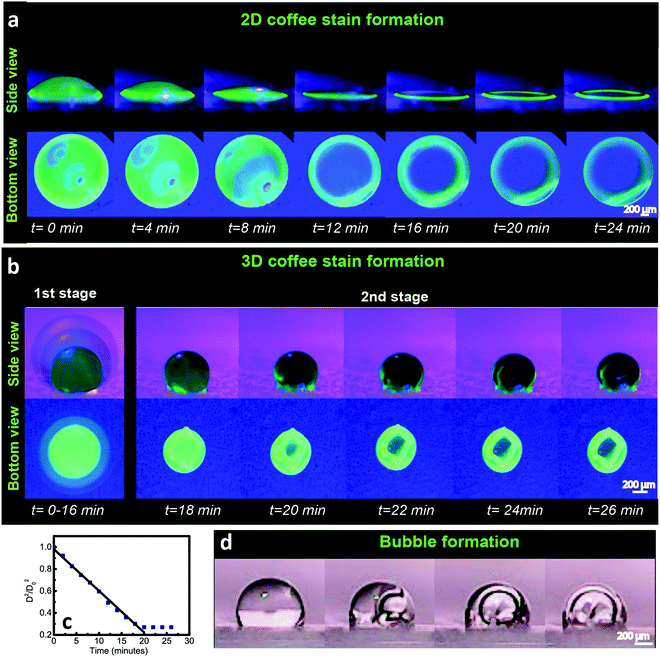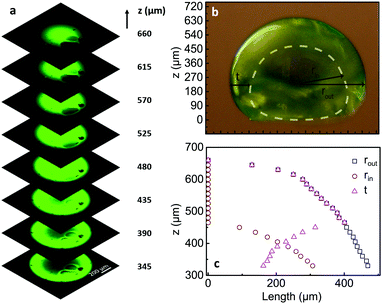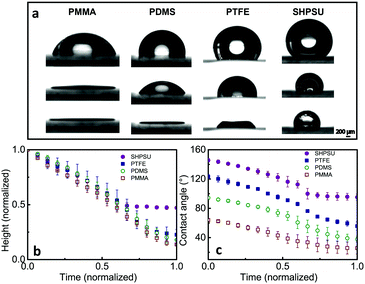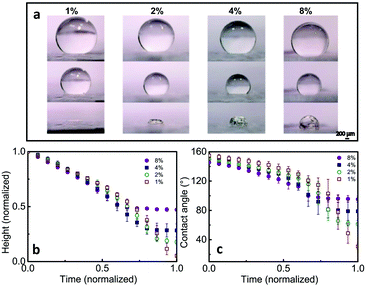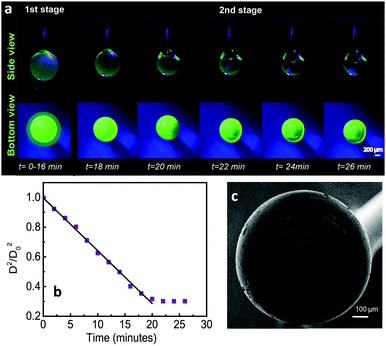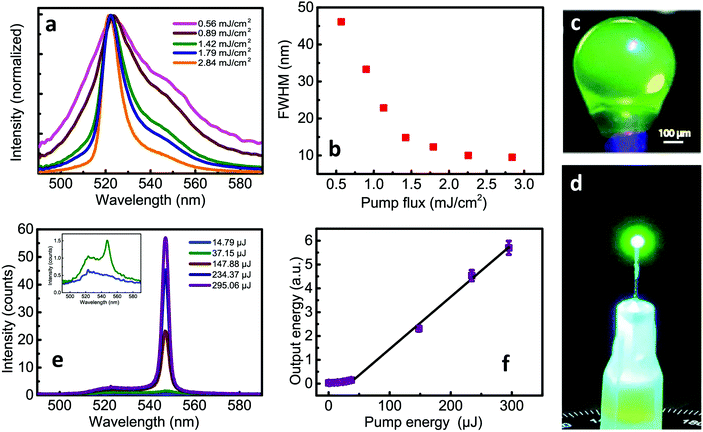3D coffee stains†
Itir Bakis
Dogru
 a,
Cagla
Kosak Soz
a,
Cagla
Kosak Soz
 bc,
Daniel Aaron
Press
d,
Rustamzhon
Melikov
bc,
Daniel Aaron
Press
d,
Rustamzhon
Melikov
 d,
Efe
Begar
e,
Deniz
Conkar
e,
Elif Nur
Firat Karalar
e,
Emel
Yilgor
bc,
Iskender
Yilgor
abc and
Sedat
Nizamoglu
*acd
d,
Efe
Begar
e,
Deniz
Conkar
e,
Elif Nur
Firat Karalar
e,
Emel
Yilgor
bc,
Iskender
Yilgor
abc and
Sedat
Nizamoglu
*acd
aGraduate School of Biomedical Sciences and Engineering, Koc University, Sariyer, Istanbul 34450, Turkey. E-mail: snizamoglu@ku.edu.tr
bDepartment of Chemistry, Koc University, Sariyer, Istanbul 34450, Turkey
cKUYTAM Surface Science and Technology Research Center, Koc University, Sariyer, Istanbul 34450, Turkey
dDepartment of Electrical and Electronics Engineering, Koc University, Sariyer, Istanbul 34450, Turkey
eDepartment of Molecular Biology and Genetics, Koc University, Sariyer, Istanbul 34450, Turkey
First published on 24th August 2017
Abstract
When a liquid droplet (e.g., coffee, wine, etc.) is splattered on a surface, the droplet dries in a ring-shaped stain. This widely observed pattern in everyday life occurs due to the phenomenon known as a coffee stain (or coffee ring) effect. While the droplet dries, the capillary flow moves and deposits the particles toward the pinned edges, which shows a 2D ring-like structure. Here we demonstrate the transition from a 2D to a 3D coffee stain that has a well-defined and hollow sphere-like structure, when the substrate surface is switched from hydrophilic to superhydrophobic. The 3D stain formation starts with the evaporation of the pinned aqueous colloidal droplet placed on a superhydrophobic surface that facilitates the particle flow towards the liquid–air interface. This leads to spherical skin formation and a cavity in the droplet. Afterwards the water loss in the cavity due to pervaporation leads to bubble nucleation and growth, until complete evaporation of the solvent. In addition to the superhydrophobicity of the surface, the concentration of the solution also has a significant effect on 3D coffee stain formation. Advantageously, 3D coffee stain formation in a pendant droplet configuration enables the construction of all-protein lasers by integrating silk fibroin with fluorescent proteins. No tools, components and/or human intervention are needed after the construction process is initiated; therefore, 3D coffee-stains hold promise for building self-assembled and functional 3D constructs and devices from colloidal solutions.
Introduction
Self-assembly is a spontaneous process that forms patterns or structures by using molecular scale movements and interactions.5,6 This process with non-covalent interactions enables the extension of the structures to visible length scales.7 A simple way to achieve self-assembled structures at a macroscale is the deposition of a colloidal solution onto a substrate, in which the interface between the substrate and solution controls the patterns of the colloids after evaporation. However, formation of free-standing and functional 2D and 3D structures generally requires the use of complex fabrication techniques, such as photolithography,8 microcontact-printing,9 inkjet-printing,10 milling,11 and laser microfabrication12 at all scales. Even though there are non-complex techniques to generate patterns using self-assembly techniques, these structures have short spatial extents and building a macroscale structure in a regular 3D pattern with embedded functionality is limited.13–18The coffee stain effect, which uses the evaporation of droplets containing colloidal suspensions and solutions on a surface, is a simple technique to generate 2D self-assembled structures on large dimensions.1,2,19,20 In an evaporating droplet, a capillary flow is generated to replenish the liquid that is lost at the edges.3,4,21 This flow drags particles towards the three phase (air–liquid–solid) contact line, forming the classical 2D ring-shaped stain in particle suspensions.21–23 So far the coffee stain effect has been used as a simple, autonomous and time-efficient approach for 2D pattern formation.21,24,25 Furthermore, a large variety of morphologies can be obtained via surface–liquid–air interactions.26–35 Different from previous reports, here we demonstrate the connection, control and transition of coffee stains from 2D to 3D structures under the same conditions including time, concentration, temperature and solution pinning. While hydrophilic surfaces with water contact angles smaller than 90° (WCA < 90°) show the formation of 2D coffee stains, superhydrophobic surfaces (WCA > 150°) lead to the formation of 3D spherical structures, which we term as a “3D coffee stain”. Furthermore, we also investigate the evaporation of pendant aqueous colloidal droplets, which result in the formation of high-quality silk fibroin spheres that incorporate fluorescent proteins for all-protein lasers.
What is a 3D coffee stain and how does it form?
The coffee stain effect, which forms the classical 2D structure, can be used to generate self-supporting 3D structures. To investigate 3D coffee stain formation, an aqueous photoluminescent silk fibroin solution modified with enhanced green fluorescent protein (eGFP) is placed on a superhydrophobic surface, with a WCA greater than 150°.36 While the same protein solution generates a 2D ring on a hydrophilic surface (Fig. 1a), a superhydrophobic surface allows the formation of a 3D spherical structure (Fig. 1b). The process from liquid droplet to 3D solid form can be divided into two main stages. As shown in Fig. 1b, in the first stage (0–16 min) the droplet volume becomes smaller due to evaporation. The spherical droplets exhibit d-square law behavior (D2/D02 = 1 − kt/D02) (Fig. 1c), where D is the droplet diameter as a function of time during the evaporation process, D0 is the initial droplet diameter, k is the evaporation rate and t is the time. This square law behavior means that the solvent and air interface dominates the droplet vaporization.37 The diameter of the droplet decreases (k = 0.037 mm2 s−1) to a steady-state value and then stays approximately the same (Fig. 1c). In addition, it is important to note that the pinned contact area both in 2D and 3D stain formation (Fig. 1a and b, respectively) stays constant during evaporation. To keep the contact area fixed, the particles in the liquid flow in a radial motion towards the edges as in 2D coffee stain formation.2 As a result, the formation of a 3D coffee stain occurs with the construction of a 2D ring at the three phase contact line, which can be considered to be the first stage.While the evaporation continues, the solvent permeation flux is higher on the surface of the droplet than in its interior and the flow due to the radial migration piles up the colloidal particles on the edges of the 2D coffee stain. The continued stacking of the particles initiates the formation of a droplet skin on the initial coffee stain ring. Furthermore, since the surface energy of water (72.6 mN mm−1) is much higher than that of silk fibroin (43–52 mN mm−1),38 skin formation also leads to substantial reduction in the overall surface energy of the system and thus, it is thermodynamically favorable. Formation of the 3D skin becomes completed on top of the 2D ring at the end of the first stage.
In the second stage (18–26 min) the radius of the skin does not significantly change (Fig. 1b) while evaporation continues. This is due to the formation of a water vapor permeable, semi-crystalline and robust silk fibroin skin on the outer layer of the droplet (Fig. S1, ESI†). At this point the droplet has a fairly dense solid–air interface, while the inside is filled with liquid. As the evaporation continues a bubble nucleates in the 3D skin (Fig. 1b), which is more clearly observable for a transparent silk fibroin droplet (Fig. 1d). The volume of the silk fibroin solution decreases as the solvent permeates through the skin, which results in the expansion of the bubble inside the droplet and reinforcement of the 3D skin. The 3D spheroid surfaces remain fairly smooth during the evaporation process (as provided in Video S1 in the ESI†). At the end of the evaporation, a 3D coffee stain is formed. The structure of a 3D coffee stain was analyzed by using confocal microscopy (Fig. 2a). The 3D coffee stain has sub-millimeter dimensions with a height of 660 μm (in the z-direction) and a maximum outer radius (rout) of 477 μm (in the xy plane) (Fig. 2b and c). Starting from the top (z = 660 μm), when we image the sphere downwards (−ẑ direction), we observe the first cavity at the z = 465 μm plane. At this point the vertical thickness of the upper wall is 215 μm and the lateral wall thickness in the xy plane (t) is 400 μm, which is equal to the outer radius. Afterwards, the internal radius (rin) of the sphere starts to increase and it reaches a value of 310 μm (at z = 330 μm). At the same time, the lateral wall thickness decreases to 170 μm. Thus, the coffee stain effect can generate well-organized and robust 3D structures on a superhydrophobic surface.
Influence of surface hydrophobicity and solution concentration on the topography of the 3D coffee stains
Our studies clearly indicate that the contact angle (CA) of the substrate is critical for the formation of 2D or 3D coffee stains. To explore the effect of the substrate surface, we kept the concentration of silk solution constant at ca. 7–9% by weight and utilized four different substrates, poly(methyl methacrylate) (PMMA) (64°), silicon rubber (PDMS) (94°), Teflon tape (PTFE) (123°) and superhydrophobic silicone-urea copolymer (SHPSU) (165°), where the WCA is provided in parenthesis. The images provided in Fig. 3a show the droplet structures at the initial (top images), mid (middle images) and final (bottom images) stages of the protein solution evaporation on these surfaces. Droplets on PMMA and PDMS surfaces resulted in coffee stains with flat domes, similar to conventional 2D coffee stains. On the other hand, the highly hydrophobic PTFE surface resulted in a collapsed dome indicating a transition from a 2D to 3D coffee stain. As the substrate surface became superhydrophobic, the protein deposition on the pinned base increased leading to skin formation and a stable 3D dome (Fig. 3b). For all samples the droplet heights decreased with time until reaching a stable level. Only the droplet on the superhydrophobic surface exhibited an earlier plateau value for dome height. Moreover, there is a correlation between the initial CA of the solution and final CA of the solid structure. As the hydrophobicity of the surface increases, the final value of the contact angle increases as well (Fig. 3c). While the CAs of the droplets on all surfaces continue to decrease until complete evaporation, the superhydrophobic surface, which starts with a CA of 145°, reaches a fairly high final CA of 95°. These results clearly demonstrate the critical effect of surface hydrophobicity on the formation of 3D coffee stains.The effect of solution concentration on the formation and the structure of the 3D coffee stain was also investigated. For this purpose droplets were deposited on a superhydrophobic surface using silk fibroin solutions with concentrations of 1.0, 2.0, 4.0 and 8.0 wt%. As expected, the initial CA is highest for the solution with the lowest concentration, which approaches the water contact angle (without any protein). On the other hand, the final CAs of the 3D stains gradually fall as the concentration decreases because a lower concentration leads to weak skin formation that starts to perturb the spherical shape of the dome and the dome may even collapse (see 1% and 2% solutions in Fig. 4a). As the concentration increases, a self-standing and spherical 3D coffee stain is formed. In addition, the time to reach the plateau values decreases with increasing concentration as expected (Fig. 4b and c).
3D coffee stains for lasers
Spherical 3D coffee stains with a smooth surface can facilitate the light oscillation in a solid–air boundary that can generate a whispering gallery mode resonator. Even though the superhydrophobic surfaces were useful to generate 3D stains, the quality of the surfaces obtained were not at a sufficient level for them to be utilized as an optical cavity. For further improvement of the structure and the surface quality of the 3D coffee stains, we adapted a pendant-drop approach. A blunt stainless steel needle was used to suspend a pendant droplet of aqueous enhanced green fluorescent protein (eGFP) blended silk fibroin solution. The spherical shape of the pendant droplet was maintained throughout the evaporation process due to a very small contact area with the needle tip. Although a perfectly spherical droplet is expected due to minimization of surface energy, as shown in Fig. 5, a slightly elongated pendant droplet is formed as a result of the gravitational force. As shown in the superimposed images provided in Fig. 5a, until the outer skin is formed, the droplet diameter shows a fairly constant rate of decrease with a slope of 0.036 mm2 s−1 (Fig. 5b), which is almost identical to that of a sessile droplet. As the evaporation proceeds, the skin formed adheres to the tip of the needle and an air bubble is formed similar to those observed on superhydrophobic surfaces. The shape and size of the droplet does not change after the skin formation and the air bubble keeps expanding until complete evaporation of water, eventually leading to the formation of a spherical 3D coffee stain with enhanced surface quality as shown in Fig. 5c. We also prepared hollow spheres using aqueous solutions of synthetic polymers, such as polyvinylpyrrolidone and polyvinylalcohol as provided in Fig. S2 (ESI†).To generate an all-protein laser, initially we explored the amplified spontaneous emission (ASE) of eGFP in transparent silk fibroin protein. A thin film of silk fibroin containing eGFP was utilized for ASE experiments using a variable stripe length (VSL) method. Using a cylindrical lens, a focused narrow line of a laser beam at 482 nm, which overlaps with the strong absorption band of eGFP, excited a stripe on the slide, which functioned as a one dimensional optical amplifier. While spontaneous emission was generated in random directions as the pump flux was increased, the emitted photons were amplified through the stripe due to population inversion and were collected. As shown in Fig. 6a, the spectral narrowing at 521 nm clearly demonstrates the amplified spontaneous emission (Fig. 6b). This result shows that fluorescent protein in a silk fibroin matrix has the potential to generate laser emission in a cavity structure.
Spherical 3D coffee stains obtained by using pendant droplets advantageously increase the surface quality for lasing (Fig. 6c). To generate laser emission, an eGFP containing silk fibroin spheroid was pumped with 5 ns OPO pulses ranging from 0.3 μJ to 234.7 μJ at 482 nm and the laser threshold behaviour was observed at 37.15 μJ, where the slope efficiency increased 7.3 times in comparison with subthreshold conditions (Fig. 6d and e). Laser emission was further confirmed with spectral narrowing above the threshold. Even though in the subthreshold regime the peak at 521 nm dominates the emission due to amplified spontaneous emission, in the suprathreshold region a new and narrow peak due to laser emission is observed at 547 nm, which drastically increases above the threshold (Fig. 6f).
Thus, the threshold and spectral behaviour proves the laser emission by the 3D stain. Due to the limited resolution of the detector (≈1 nm) the longitudinal and transverse modes were not distinguishable for such a milimeter-scale sphere. The 3D spheres obtained using aqueous silk fibroin solutions, which are biodegradable, biocompatible and transparent have unique properties for cavity formation. Moreover, the biologically produced fluorescent protein of eGFP represents an important natural biomolecule as a laser gain medium in silk fibroin.39 Thus, the spherical 3D coffee stains obtained using pendant droplets of eGFP modified silk fibroin solutions enabled the construction of all-protein lasers.
Conclusions
In conclusion, while hydrophilic surfaces lead to the formation of conventional 2D coffee stains, it has been demonstrated that superhydrophobic surfaces facilitate the formation of 3D coffee stains. The 3D coffee stain formation starts with the evaporation of the droplets where the particles move toward the pinned edges, leading to skin formation. As the evaporation continues a bubble nucleates, expands and forms a hollow cavity inside the skin, which results in 3D coffee stain formation. Furthermore, spherical 3D coffee stains with excellent surface quality can be produced by the evaporation of a pendant droplet, which leads to all-protein lasers when eGFP doped silk fibroin proteins are utilized. The spheres can further be modified with a wide variety of magnetic and optical nanomaterials to demonstrate novel free-standing devices by self-assembly. Furthermore, this study can open-up new scientific avenues for the dynamics and modelling of interfacial interactions and investigations of unconventional 3D systems.Experimental
Materials
Poly(methyl methacrylate) (PMMA) (Mn = 190![[thin space (1/6-em)]](https://www.rsc.org/images/entities/char_2009.gif) 000, Mw = 305
000, Mw = 305![[thin space (1/6-em)]](https://www.rsc.org/images/entities/char_2009.gif) 000 g mol−1) was synthesized in our laboratories. PDMS was prepared using a Sylgard® 184 Silicone Elastomer kit. Teflon tapes were obtained from Resiflon, Du Pont, Italy. Polydimethylsiloxane-urea copolymer (Geniomer TPSC 140) with a PDMS (Mn = 3200 g mol−1) content of about 92% by weight and hydrophobic fumed silica (HDK H2000) were kindly provided by Wacker Chemie, Munich, Germany. The primary particle size for fumed silica is reported to be 5–30 nm, which increases to 100–250 nm after aggregation. The specific surface area of the particles is 170–230 m2 g−1. Deionized and triple distilled water was prepared in our laboratories. Reagent grade solvents, toluene, isopropyl alcohol (IPA) and tetrahydrofuran (THF), were obtained from Merck and used as received.
000 g mol−1) was synthesized in our laboratories. PDMS was prepared using a Sylgard® 184 Silicone Elastomer kit. Teflon tapes were obtained from Resiflon, Du Pont, Italy. Polydimethylsiloxane-urea copolymer (Geniomer TPSC 140) with a PDMS (Mn = 3200 g mol−1) content of about 92% by weight and hydrophobic fumed silica (HDK H2000) were kindly provided by Wacker Chemie, Munich, Germany. The primary particle size for fumed silica is reported to be 5–30 nm, which increases to 100–250 nm after aggregation. The specific surface area of the particles is 170–230 m2 g−1. Deionized and triple distilled water was prepared in our laboratories. Reagent grade solvents, toluene, isopropyl alcohol (IPA) and tetrahydrofuran (THF), were obtained from Merck and used as received.
Preparation of aqueous silk fibroin solution
5 g Bombyx Mori silk cocoons were boiled in 2 L of 0.02 M aqueous Na2CO3 solution for 30 min to remove sericin and extract the fibroin. Extracted silk fibroin was rinsed and stirred in cold deionized water twice after changing the water between each process and then dried in air at room temperature. Dried silk fibroin was dissolved in 9.3 M LiBr solution and placed in an oven at 60 °C for 4 hours. Viscous silk fibroin solution was injected into a dialysis cassette to separate LiBr and other contaminants. This procedure was continued for 2 days changing the water at regular time intervals. Finally the silk fibroin solution taken from the dialysis cassette was centrifuged at 9000 rpm at −2 °C for 20 minutes twice.40 The final concentration of the silk fibroin solution was determined by Gravimetric Analysis and it was measured between 7 and 9 wt%.Fluorescent protein expression and purification
GFP fluorescent proteins are prepared using transformed Escherichia coli cells. First a GST tag containing vector is transformed into E. coli cells and the cells are grown on plates. The eGFP protein is 30 kDa and the GST tag is linked to the N terminal of the protein, which is 26 kDa, for the eGFP-GST vector. A bacterial colony is chosen and induced in large scale broth. Proteins are expressed using 1 mM isopropyl β-D-1-thiogalactopyranoside. After protein expression, the bacteria cells are pelleted with centrifugal force, and the cells are lysed with lysozyme and washed with GST Wash Buffer (1× PBS (phosphate-buffered saline), 0.25 M KCl, freshly supplied with 25 μg mL−1 LPC, 17.4 μg mL−1 PMSF, and 10 μg mL−1 Aprotinin). After freeze-thawing and sonicating the cells, protein purification is performed by superflow glutathione agarose beads. Elution buffer (50 mM Tris pH 8.0, 10 mM glutathione, freshly supplied with 10 mM DTT, 25 μg mL−1 LPC) is added to the proteins and the proteins are eluted with the use of centrifugal filters. The proteins are concentrated using the same filters. As eGFP is concentrated, 1× PBS (phosphate buffered saline) is passed through the filter until eGFP is concentrated down to 250–300 μL. Then fluorescent proteins are desalted using dialysis membranes.Fabrication of the substrates
Smooth surfaces based on PMMA and PSU were prepared by spin coating of polymer solutions on glass substrates.41 Teflon tapes were stretched onto glass lams to obtain flat surfaces. Superhydrophobic polydimethylsiloxane-urea (SHPSU) surfaces were prepared by spin coating of silica dispersions in PSU onto glass substrates as reported earlier36,41,42 (Fig. S3, ESI†).Characterization techniques
Static water contact angle measurements were performed on a Dataphysics OCA 35 instrument at room temperature (24 ± 2 °C). The dataphysics OCA 35 instrument was equipped with SCA 20 software which provided the electronic control of the device parameters and the monitoring and measurement of the contact angles. The contact angles reported are an average of a minimum of three measurements. Bottom view images are taken by an Olympus CK40 inverted microscope; the samples were illuminated with an additional blue LED where the side views are recorded simultaneously by a CCD camera. Confocal microscopy was carried out via a Nikon C2si Confocal Microscope with a scanning laser at a wavelength of 488 nm. Surface structures and topographies were determined using a scanning electron microscope (SEM) (ZEISS EVO LS15) at 2 kV. Samples were coated with a 2–3 nm gold layer to minimize the charging of the surface. ATR-IR spectra were recorded on a ThermoScientific Smart iTR spectrometer equipped with a diamond ATR crystal, with an incident angle of 42°. 16 scans were taken for each spectrum with a resolution of 4 cm−1.Silk fibroin and eGFP thin film preparation for ASE experiments
Silk fibroin solution (7–9 wt%) and concentrated eGFP solution (7.96 mg mL−1) were mixed with a ratio of 1![[thin space (1/6-em)]](https://www.rsc.org/images/entities/char_2009.gif) :
:![[thin space (1/6-em)]](https://www.rsc.org/images/entities/char_2009.gif) 1 in volume. 80 μL of this mixture solution was spin coated on a 1 mm × 1 mm glass substrate for 1 minute at 3000 rpm.
1 in volume. 80 μL of this mixture solution was spin coated on a 1 mm × 1 mm glass substrate for 1 minute at 3000 rpm.
Silk fibroin and eGFP spheroid crystals for lasing experiments
Silk fibroin solution and concentrated eGFP solution were mixed at a ratio of 1![[thin space (1/6-em)]](https://www.rsc.org/images/entities/char_2009.gif) :
:![[thin space (1/6-em)]](https://www.rsc.org/images/entities/char_2009.gif) 1 by volume. With a headstand 1 mL injector and 32 G stainless steel blunt needle, a small droplet was slowly released to the tip of the needle.
1 by volume. With a headstand 1 mL injector and 32 G stainless steel blunt needle, a small droplet was slowly released to the tip of the needle.
Optical set-up for lasing and ASE experiments
A Quanta-Ray INDI pulsed Nd:YAG laser with a BasiScan OPO (SpectraPhysics) was used. The pump with a repetition rate of 10 Hz was passed through an OD filter where the laser energy is adjusted. Then, the laser arrives on the sample via a 10× microscope objective. The emitted light from the sample was collected by a fiber placed to the side of the sample (i.e., orthogonal to the direction of the pump light) and reached the spectrometer (Torus Concave Grating Spectrometer, Ocean Optics) as shown in Fig. S4 (ESI†). For ASE experiments, a cylindrical lens was inserted in the optical set-up instead of the microscope objective.Droplet size calculations
All the calculations were carried out using ImageJ software.Conflicts of interest
There are no conflicts to declare.Acknowledgements
S. N. acknowledges the support by Marie Curie Career Integration Grant (PROTEINLED, 631679), and The Scientific and Technological Research Council of Turkey (TUBITAK) under projects 114F317, 115F451. Also, SN acknowledges additional support from the Turkish Academy of Sciences Distinguished Young Scientist Award (TUBA GEBIP) and FABED Eser Tümen Research Award. We thank Prof. Kerem Pekkan and Selda Göktaş for their support in confocal microscopy measurements and Özgün Can Önder for his assistance of taking SEM images.References
- H. B. Eral, D. M. Augustine, M. H. G. Duits and F. Mugele, Suppressing the coffee stain effect: how to control colloidal self-assembly in evaporating drops using electrowetting, Soft Matter, 2011, 7(10), 4954–4958 RSC
.
- R. D. Deegan, O. Bakajin, T. F. Dupont, G. Huber, S. R. Nagel and T. A. Witten, Capillary flow as the cause of ring stains from dried liquid drops, Nature, 1997, 389(6653), 827–829 CrossRef CAS
.
- P. J. Yunker, D. J. Durian and A. G. Yodh, Coffee rings and coffee disks: physics on the edge, Phys. Today., 2013, 66(8), 60–61 CrossRef
.
- P. J. Yunker, M. A. Lohr, T. Still, A. Borodin, D. J. Durian and A. G. Yodh, Effects of Particle Shape on Growth Dynamics at Edges of Evaporating Drops of Colloidal Suspensions, Phys. Rev. Lett., 2013, 110(3), 035501 CrossRef PubMed
.
- G. M. Whitesides and M. Boncheva, Beyond molecules: Self-assembly of mesoscopic and macroscopic components, Proc. Natl. Acad. Sci. U. S. A., 2002, 99(8), 4769–4774 CrossRef CAS PubMed
.
- G. M. Whitesides and B. Grzybowski, Self-assembly at all scales, Science, 2002, 295(5564), 2418–2421 CrossRef CAS PubMed
.
- A. K. Boal, F. Ilhan, J. E. DeRouchey, T. Thurn-Albrecht, T. P. Russell and V. M. Rotello, Self-assembly of nanoparticles into structured spherical and network aggregates, Nature, 2000, 404(6779), 746–748 CrossRef CAS PubMed
.
-
W. M. Moreau, Semiconductor lithography: principles, practices, and materials, Springer Science & Business Media, 2012 Search PubMed
.
- R. J. Jackman, J. L. Wilbur and G. M. Whitesides, Fabrication of submicrometer features on curved substrates by microcontact printing, Science, 1995, 269(5224), 664 CAS
.
-
H. Lipson and M. Kurman, Fabricated: the new world of 3D printing, John Wiley & Sons, 2013 Search PubMed
.
- E. L. Bohez, Five-axis milling machine tool kinematic chain design and analysis, International Journal of Machine Tools and Manufacture, 2002, 42(4), 505–520 CrossRef
.
-
H. Misawa and S. Juodkazis, 3D laser microfabrication: principles and applications, John Wiley & Sons, 2006 Search PubMed
.
- C. A. Mirkin, R. L. Letsinger, R. C. Mucic and J. J. Storhoff, A DNA-based method for rationally assembling nanoparticles into macroscopic materials, Nature, 1996, 382(6592), 607–609 CrossRef CAS PubMed
.
- R. C. Mucic, J. J. Storhoff, C. A. Mirkin and R. L. Letsinger, DNA-directed synthesis of binary nanoparticle network materials, J. Am. Chem. Soc., 1998, 120(48), 12674–12675 CrossRef CAS
.
- A. P. Alivisatos, K. P. Johnsson, X. Peng, T. E. Wilson, C. J. Loweth and M. P. Bruchez Jr,
et al., Organization of ‘nanocrystal molecules’ using DNA, Nature, 1996, 382(65), 609–611 CrossRef CAS PubMed
.
- J. V. Timonen, M. Latikka, L. Leibler, R. H. Ras and O. Ikkala, Switchable static and dynamic self-assembly of magnetic droplets on superhydrophobic surfaces, Science, 2013, 341(6143), 253–257 CrossRef CAS PubMed
.
- R. P. Andres, J. D. Bielfeld, J. I. Henderson and D. B. Janes, Self-assembly of a two-dimensional superlattice of molecularly linked metal clusters, Science, 1996, 273(5282), 1690 CrossRef CAS
.
- R. Van Hameren, P. Schön, A. M. Van Buul, J. Hoogboom, S. V. Lazarenko and J. W. Gerritsen,
et al., Macroscopic hierarchical surface patterning of porphyrin trimers via self-assembly and dewetting, Science, 2006, 314(5804), 1433–1436 CrossRef CAS PubMed
.
- W. Han and Z. Lin, Learning from “Coffee Rings”: Ordered Structures Enabled by Controlled Evaporative Self-Assembly, Angew. Chem., Int. Ed., 2012, 51(7), 1534–1546 CrossRef CAS PubMed
.
- P. J. Yunker, T. Still, M. A. Lohr and A. Yodh, Suppression of the coffee-ring effect by shape-dependent capillary interactions, Nature, 2011, 476(7360), 308–311 CrossRef CAS PubMed
.
- Á. G. Marín, H. Gelderblom, D. Lohse and J. H. Snoeijer, Order-to-disorder transition in ring-shaped colloidal stains, Phys. Rev. Lett., 2011, 107(8), 085502 CrossRef PubMed
.
- H. Ma and J. Hao, Ordered patterns and structures via interfacial self-assembly: superlattices, honeycomb structures and coffee rings, Chem. Soc. Rev., 2011, 40(11), 5457–5471 RSC
.
- X. Shen, C.-M. Ho and T.-S. Wong, Minimal size of coffee ring structure, J. Phys. Chem. B, 2010, 114(16), 5269–5274 CrossRef CAS PubMed
.
- C. N. Kaplan, N. Wu, S. Mandre, J. Aizenberg and L. Mahadevan, Dynamics of evaporative colloidal patterning, Phys. Fluids, 2015, 27(9), 092105 CrossRef
.
- C. N. Kaplan and L. Mahadevan, Evaporation-driven ring and film deposition from colloidal droplets, J. Fluid Mech., 2015, 781, R2 CrossRef
.
- Z. S. Davidson, Y. Huang, A. Gross, A. Martinez, T. Still and C. Zhou,
et al., Deposition and drying dynamics of liquid crystal droplets, Nat. Commun., 2017, 8, 15642 CrossRef CAS PubMed
.
- D. Sen, S. Mazumder, J. Melo, A. Khan, S. Bhattyacharya and S. D'souza, Evaporation driven self-assembly of a colloidal dispersion during spray drying: volume fraction dependent morphological transition, Langmuir, 2009, 25(12), 6690–6695 CrossRef CAS PubMed
.
- A. Crivoi and F. Duan, Three-dimensional Monte Carlo model of the coffee-ring effect in evaporating colloidal droplets, Sci. Rep., 2014, 4, 4310 CrossRef CAS PubMed
.
- C. L. Sadek, H. Tabuteau, P. Schuck, Y. Fallourd, N. Pradeau and C. C. Le Floch-Fouéré,
et al., Shape, shell, and vacuole formation during the drying of a single concentrated whey protein droplet, Langmuir, 2013, 29(50), 15606–15613 CrossRef CAS PubMed
.
- L. Pauchard and C. Allain, Stable and unstable surface evolution during the drying of a polymer solution drop, Phys. Rev. E: Stat., Nonlinear, Soft Matter Phys., 2003, 68(5), 052801 CrossRef CAS PubMed
.
- Á. G. Marín, H. Gelderblom, A. Susarrey-Arce, A. van Houselt, L. Lefferts and J. G. Gardeniers,
et al., Building microscopic soccer balls with evaporating colloidal fakir drops, Proc. Natl. Acad. Sci. U. S. A., 2012, 109(41), 16455–16458 CrossRef PubMed
.
- A. Accardo, F. Gentile, F. Mecarini, F. De Angelis, M. Burghammer and E. Di Fabrizio,
et al.In situ X-ray scattering studies of protein solution droplets drying on micro-and nanopatterned superhydrophobic PMMA surfaces, Langmuir, 2010, 26(18), 15057–15064 CrossRef CAS PubMed
.
- A. Accardo, F. Di Stasio, M. Burghammer, C. Riekel and R. Krahne, Nanocrystal Self-Assembly into Hollow Dome-Shaped Microstructures by Slow Solvent Evaporation on Superhydrophobic Substrates, Part. Part. Syst. Charact., 2015, 32(5), 524–528 CrossRef CAS
.
- F. Parisse and C. Allain, Drying of colloidal suspension droplets: experimental study and profile renormalization, Langmuir, 1997, 13(14), 3598–3602 CrossRef CAS
.
- Y. Zhang, S. Yang, L. Chen and J. Evans, Shape changes during the drying of droplets of suspensions, Langmuir, 2008, 24(8), 3752–3758 CrossRef CAS PubMed
.
- C. K. Söz, E. Yilgör and I. Yilgör, Influence of the coating method on the formation of superhydrophobic silicone–urea surfaces modified with fumed silica nanoparticles, Prog. Org. Coat., 2015, 84, 143–152 CrossRef
.
- R.-H. Chen, T. X. Phuoc and D. Martello, Effects of nanoparticles on nanofluid droplet evaporation, Int. J. Heat Mass Transfer, 2010, 53(19), 3677–3682 CrossRef CAS
.
- J. Zhang, S. Du, A. Kafi, B. Fox, J. L. Li and X. Y. Liu,
et al., Surface energy of silk fibroin and mechanical properties of silk cocoon composites, RSC Adv., 2015, 5(2), 1640–1647 RSC
.
- M. C. Gather and S. H. Yun, Bio-optimized energy transfer in densely packed fluorescent protein enables near-maximal luminescence and solid-state lasers, Nat. Commun., 2014, 5, 5722 CrossRef CAS PubMed
.
- D. N. Rockwood, R. C. Preda, T. Yucel, X. Q. Wang, M. L. Lovett and D. L. Kaplan, Materials fabrication from Bombyx mori silk fibroin, Nat. Protoc., 2011, 6(10), 1612–1631 CrossRef CAS PubMed
.
- C. K. Söz, E. Yilgör and I. Yilgör, Influence of the average surface roughness on the formation of superhydrophobic polymer surfaces through spin-coating with hydrophobic fumed silica, Polymer, 2015, 62, 118–128 CrossRef
.
- C. K. Söz, E. Yilgör and I. Yilgör, Simple processes for the preparation of superhydrophobic polymer surfaces, Polymer, 2016, 99, 580–593 CrossRef
.
Footnote |
| † Electronic supplementary information (ESI) available. See DOI: 10.1039/c7qm00281e |
| This journal is © the Partner Organisations 2017 |


